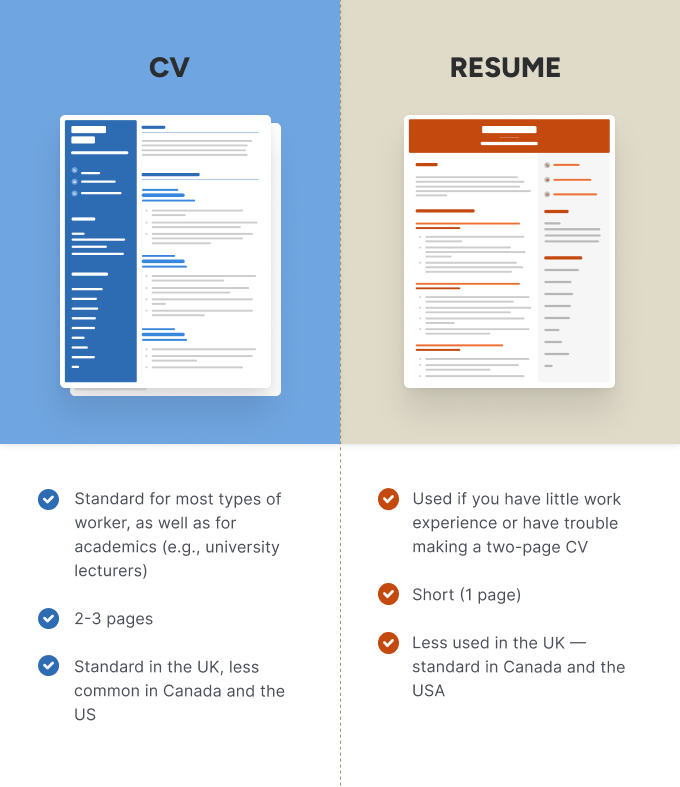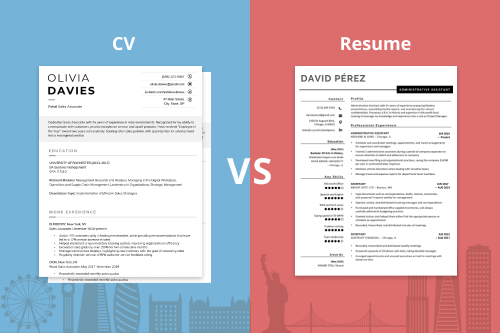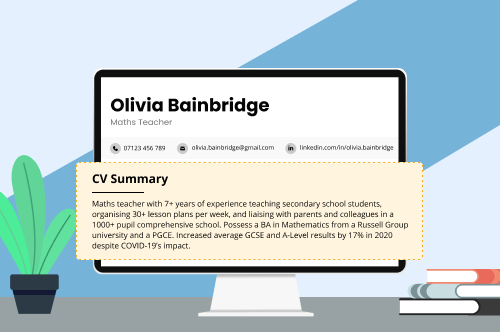CVs and resumes are both job application documents. ‘CV’, which stands for curriculum vitae, tends to be the name used in the UK and Europe, while ‘resume’ is the standard name used in the USA and Canada.
Learn how to write a CV if you’re:
- applying for jobs in the UK and Europe
- applying for jobs at British or European firms in the USA
Make a resume if you’re:
- applying for jobs in the USA or Canada
- applying for jobs at US companies in the UK or EU
Looking to emigrate to the UK? Check how you can get the right to work in the UK and learn how to write an English CV before you start submitting job applications.

What is a CV?
A CV is a job application document used in the UK, Ireland, and EU that shows employers why you deserve an interview. A good CV highlights your educational and professional background, including your:
- key skills
- work experience
- qualifications and certifications
Countries that use CVs
- The UK
- Ireland
- The EU
- Norway
- Switzerland
- Iceland
- New Zealand
- Most other Commonwealth countries
What is a resume?
A resume is the main job application document used in North America (the US and Canada). The main difference is in length: a CV is usually 2 pages, whereas a resume is 1 page.
But examples of similarities between CVs and resumes are that they both:
- should use an easy-to-read font
- have a personal introduction
- don’t include a headshot (unless you’re looking for work in the EU)
Countries that use resumes
- The USA
- Canada
Countries where you can say either ‘CV’ or ‘resume’
- Singapore
- Malaysia
- India (you can say ‘biodata’ too)
- Australia
- South Africa
Here are more details about how resumes differ from CVs:
CV vs resume: 3 main differences
Here are the 3 key CV vs resume differences:
1. CVs are longer
CVs are longer than resumes because UK employers expect to learn all about your professional and educational background, like unrelated jobs and your GCSE/A-Level (or Scottish Highers/Advanced) grades.
They also want to get a taste of your personality through your hobbies and free-time pursuits before they decide whether to interview you.
In the UK, you can write a CV of between 2 and 4 pages — and even dozens of pages for an academic CV (for example, a university lecturer).
For a resume, you’ll keep your content on one page, making it easier for US recruiting managers to quickly read.
2. CVs are more detailed
Another difference between a CV and a resume is how much detail they go into.
Let’s compare the work experience and education sections of a CV and a resume:
Work history
UK and Irish employers expect to see your entire work history on your CV. That’s why they’re 2+ pages long.
By contrast, US employers want to see how you fit your relevant work history onto one page — so consider removing work experience that doesn’t have anything to do with the job you’re currently seeking.
Education
Another example is in the education section of your CV. A CV in the UK or Ireland should always include:
- your university degrees
- your A-Levels (or Irish/Scottish equivalents)
- the number of GCSEs you were awarded (or Irish/Scottish equivalents) graded between 9 and 4 (or A* and C before 2017)
Also, provide your GCSE grades for English, Maths, and ICT if you haven’t studied these subjects at A-Level, so employers can see you have the minimum literacy, numeracy, and ICT skills to function in the workplace.
By contrast, resumes usually only contain the highest degree you’ve obtained. So if you’ve got a BSc in Chemistry, that’s all you’d list on a resume. Leave off your A-Levels and GCSEs.
US employers won’t understand British degree classifications, so if you’re a Brit applying for a US job, convert your degree classification to a US ‘GPA’ number (grade point average), and add it to your resume.
3. CVs have multiple purposes
A CV and a well-written cover letter are used to apply for all jobs in the UK and Europe.
In the US, a resume is used to apply for most jobs, and a multi-page CV is used to apply for academic roles in American universities.
If you’re applying for a postgrad course like a master’s degree or Ph.D., there’s no limit on the number of pages for your academic CV. The same goes for lecturers, professors, and researchers at universities — 20+ page CVs aren’t uncommon!
3 frequently asked CV vs resume questions
Want more information? We prepared 3 answers to commonly asked questions to give you more tips on CVs and resumes:
1. How do you build a CV?
Building a CV is easy. Just use a high-quality CV maker. It’ll ask you a few standard questions and then generate your document in minutes.
Cover letters are standard in the UK, so you’ll also need to make your own cover letter online — don’t worry, it’ll be done in the time it takes to make a cup of tea.
2. What is a CV sample?
A CV sample is an example of a CV targeting a specific job. For example, if you’re applying to be a customer service advisor, looking at a sample customer service advisor CV is helpful. You can see the kinds of work experience employers are expecting and the types of qualifications and skills you’ll need.
On the other hand, a resume sample is the same idea but for a one-page resume.
You can download samples to your computer in .docx format so you can edit them to fit your own background (doing this will be a bit slower than using a CV builder, though).
3. How do you turn a CV into a resume for a US job?
If an employer asks for a resume instead of a CV, it’s straightforward:
- Remove any irrelevant jobs from the document. On a CV, you usually include every single job you’ve had. On a resume, you just include jobs relevant to the position you’re applying for. For example, if you’ve worked as a graphic designer, and are applying for a senior graphic design role, cut out those Asda customer service or Uber Eats delivery roles you had back in uni.
You should also remove any jobs that you held 15+ years ago. As well as helping you cut your CV down to resume size, it’ll also help protect you against age discrimination.
- Remove certain sections that are standard on a CV but just take up space on a resume — for example, your hobbies and interests section
- Try using a smaller resume/CV font size — but 10 should be the minimum font size on CVs and resumes. Other CV formatting hacks include:
- reducing your margins down to a max of 1.25 cm
- removing personal info like your full postal address, marital status, nationality, date of birth, National Insurance Number etc. (you shouldn’t list these personal details on your CV anyway)
- using a narrower font like Arial Narrow (you’ll be able to fit more text on your page).
Reddit and Quora questions about CVs vs resumes
Here are 3 pressing questions people are asking on the web:
- Do I need both a resume and a CV?
- If an employer asks for either a CV or a resume, should I submit both?
- Why do Americans call a ‘CV’ a ‘resume’?
1. Do I need both a resume and a CV?
This question was asked by a freelance writer on Reddit.
No, usually you don’t need both a resume and a CV. The only case where you would need both is if you’re applying for jobs in both the US and the UK. In that case, you’ll need the shorter resume for the US and the more in-depth CV for the UK.
2. If an employer asks for either a CV or a resume, should I submit both?
User /ashtastic3 asks this question on Reddit.
No, in this case, the employer is letting you choose which document to send. If you already have a CV prepared, send it to the employer.
If the job opening is in the UK or Commonwealth, use British English; if the job is in the US, use American English.
3. Why do Americans call a ‘CV’ a ‘resume’?
We found this question on Quora.
It’s unclear why Americans started using the word ‘resume’ instead of ‘CV’, but the word ‘resume’ comes from the French verb ‘résumer‘, which means ‘to summarise’ so it still makes sense.
More FAQs about CV and resume writing
Applying for UK-based roles? Below are answers to additional questions that’ll help you make a great CV or resume:




